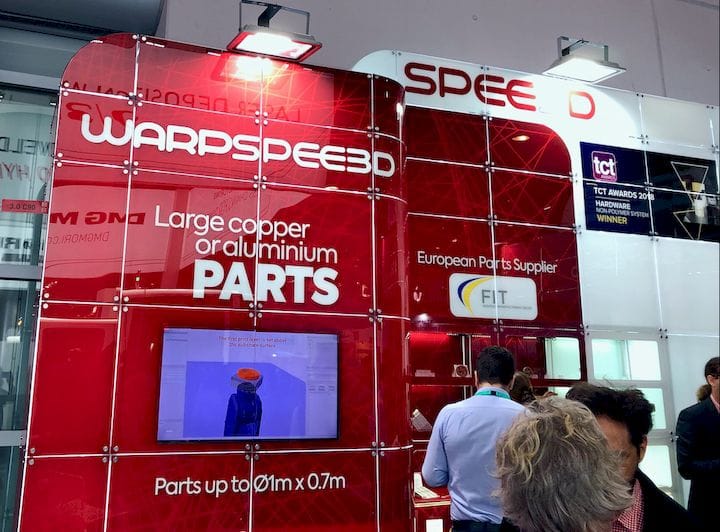![SPEE3D’s new WarpSpee3D metal 3D printer [Source: Fabbaloo]](https://fabbaloo.com/wp-content/uploads/2020/05/image-asset_img_5eb0a00327d25.jpg)
Australia-based SPEE3D has refined their supersonic 3D printing process.
Their unique process involves blasting fine particles of a metal powder towards a target at literally supersonic speeds, hence the company’s name. The energy carried by the swiftly moving particles causes the powder to bond to the target, thus gradually forming a fully 3D metal object.
The key advantages of their process include a more rapid rate of 3D printing, which is quite a bit faster than typical powder-bed laser processes. In addition, their process also allows use of powdered metals that are not easily used or even impossible in several alternative metal 3D printing processes. Copper, for example, is a popular metal used in SPEE3D systems, but that material is rarely found in alternative systems.
It’s also now possible to mix different powdered metals to form dynamic alloys, as well as mixing materials together. For example, SPEE3D’s machines have produced complex heat sinks in aluminum that use copper features to carry heat, suitable for outdoor use. SPEE3D can now produce multi-component structures, and this is a fascinating development.
![Copper wheel 3D printed in only twelve minutes by SPEE3D [Source: Fabbaloo]](https://fabbaloo.com/wp-content/uploads/2020/05/image-asset_img_5eb0a00384bae.jpg)
But as always, the biggest advantage of SPEE3D’s process is the cost of 3D printing; it’s significantly less than alternative processes. The copper wheel pictured above, for example, was produced in only twelve minutes and cost only US$10. That’s a huge price advantage.
This larger copper wheel, which is about a meter in diameter, was 3D printed in only six hours:
![A large copper wheel 3D printed in only six hours by SPEE3D [Source: Fabbaloo]](https://fabbaloo.com/wp-content/uploads/2020/05/image-asset_img_5eb0a003eaa50.jpg)
However, the level of detail and resolution on parts produced with SPEE3D’s process are not nearly as fine as can be found on some alternative metal 3D printing processes. This has meant that SPEE3D is targeting foundries as its main market, where plenty of non-detail metal parts are typically produced.
The strategy there is to enable a foundry to produce low-volume part runs, say 5-100 units. Using normal manufacturing processes, a low number of units could often be prohibitively expensive to produce. This might open up entirely new markets for local foundries. SPEE3D can produce the part faster yet at the same cost.
One way of looking at this would be the foundry would have a choice of producing a detailed quote for a low-volume project in a week, or just execute the job entirely with SPEE3D’s technology in only three days. This technology could change the game for local foundries.
Another improvement to SPEE3D’s process is their work on nozzle reliability, in particular for certain materials. The nozzle obviously undergoes significant stress as it’s blasting metal particles at supersonic speed. They explained to us that this work is often a balance between avoiding wear and clogging the nozzle, which are mutually exclusive.
The company’s flagship machine, the LightSPEE3D printer, is to be joined by a larger machine, the WarpSPEE3D. This machine is likely to use the same internal components, but in a larger build volume, apparently 1000 diameter x 700 mm (SPEE3D prints in a cylindrical build volume.)
We’re quite impressed with the SPEE3D solution, as it is not just a metal 3D printer; it’s a metal 3D printer that’s designed for a specific industry that’s largely been ignored by the rest of the 3D printing world.
Via SPEE3D











Aerosint and Aconity have proven out their work in multi-metal powder deposition 3D printing.